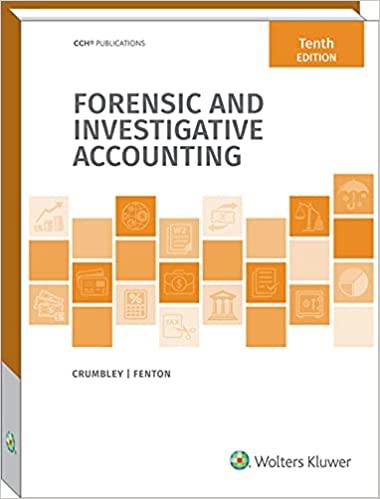Question
Q1) California Surplus Inc. qualifies to use the installment-sales method for tax purposes and sold an investment on an installment basis. The total gain of
Q1) California Surplus Inc. qualifies to use the installment-sales method for tax purposes and sold an investment on an installment basis. The total gain of $75000 was reported for financial reporting purposes in the period of sale. The installment period is 3 years; one-third of the sale price is collected in 2012 and the rest in 2013. The tax rate was 35% in 2012, and 30% in 2013 and 30% in 2014. The accounting and tax data is shown below. Financial Accounting Tax Return 2012 (40% tax rate) Income before temporary difference $ 175,000 $ 175,000 Temporary difference $ 75,000 $ 25,000 Income $ 250,000 $ 200,000 2013 (35% tax rate) Income before temporary difference $ 200,000 $ 200,000 Temporary difference $ - $ 25,000 Income $ 200,000 $ 225,000 2014 (35% tax rate) Income before temporary difference $ 180,000 $ 180,000 Temporary difference $ - $ 25,000 Income $ 180,000 $ 205,000 Required: 1) Prepare the journal entries to record the income tax expense, deferred income taxes, and the income taxes payable for 2012, 2013, and 2014. No deferred income taxes existed at the beginning of 2012. 2) Explain how the deferred taxes will appear on the balance sheet at the end of each year. (Assume Installment Accounts Receivable is classified as a current asset.) 3) Show the income tax expense section of the income statement for each year, beginning with ?Income before income taxes.? Q2) The Ambrosia Corporation's lead accountant shows the following info: On Jan 1, 2012, Ambrosia purchased a bottling machine for $800000 A) Straight-line basis depreciation for 5 years for tax purposes B) Half year convention for 8 years for financial reporting (See Appendix 11A.) C) Tax- exempt municipal bonds yielded interest of $150000 in 2013. D) Pretax financial income is $2300000 in 2012 and $2400000 in 2013. E) The company recognized an extraordinary gain of $150000 in 2013 (which is fully taxable). F) Taxable income is expected in future years with an expected tax rate of 35%. Required: 1) Compute taxable income and income taxes payable for 2013. 2) Prepare the journal entries for income tax expense, income taxes payable, and deferred taxes for 2013. 3) Prepare the deferred income taxes presentation for Dec 31, 2013 balance sheet. 
Step by Step Solution
There are 3 Steps involved in it
Step: 1

Get Instant Access to Expert-Tailored Solutions
See step-by-step solutions with expert insights and AI powered tools for academic success
Step: 2

Step: 3

Ace Your Homework with AI
Get the answers you need in no time with our AI-driven, step-by-step assistance
Get Started


